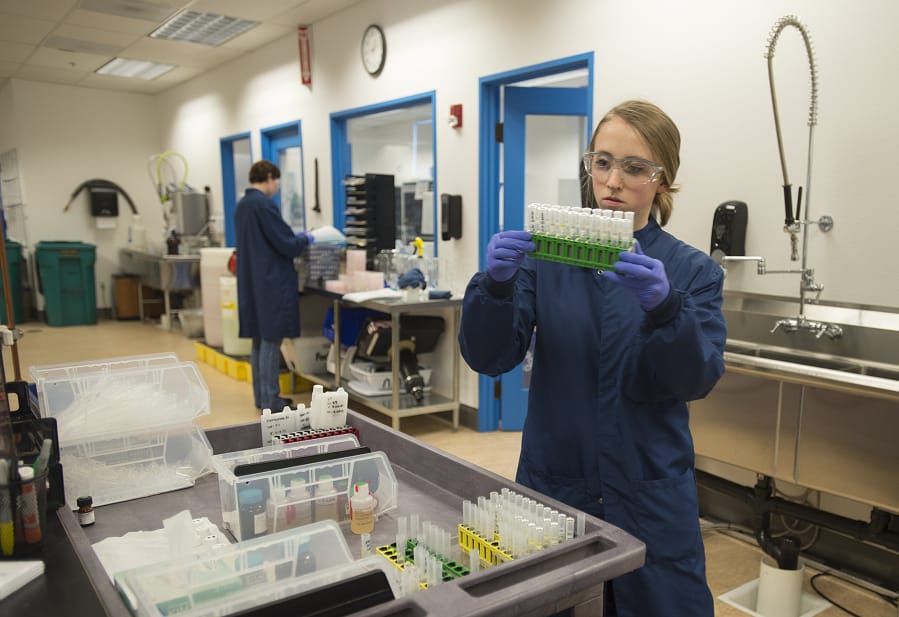Jonathan DeHart had hoped to land his company, a fledgling manufacturer of gene sequencing devices borne out of incubators at Intel, in the Portland-Vancouver metropolitan area. Then they found a glitch.
The kind of space that they were looking for, called wet lab space, wasn’t very abundant here. As a young company still raising its early funds, they had to find space to rent. Building their own space was a nonstarter.
“When you’re young and early, you’ve got to put your capital toward tech development,” he said. “You can’t be spending $300,000 to a $1 million just to build a space to start working.”
Northshore Bio, as it would eventually be called, made a compromise: locate its administrative offices in Camas, near the robust research scene revolving around Oregon Health & Science University, and its wet lab space in Seattle.
It’s one company’s story, but it offers a glimpse into some directions Clark County has to take to reach its goal of becoming a hotbed for life sciences firms. Seattle has a road map: a powerhouse research institution in its backyard, capital investors, and it is loaded with lab space and other infrastructure.
Clark County has some efforts in the works to get there, but how they will play out remains to be seen.
Petri dish culture
Life sciences is a broad label, but the sector is on the upswing.
Professionals in the field mainly work to advance human health. Food scientists, meteorologists, chemists, biologists and even economists can find work in life science companies, which might make or test drugs or manufacture new tools.
According to the Columbia River Economic Development Council, the stable of workers who could fill these jobs has grown by 8.8 percent between 2012 and 2016. It expects to grow by another 12.5 percent by 2026, it said. Clark County has more than 70 firms today, the majority of which are testing labs, medical labs or pharmaceutical drug wholesalers.
Mike Bomar, president of the public-private agency, said growing that field would catalyze the whole area. It would plant more high-paying, long-tenured jobs that would then circulate their success through local trade.
“These are high-wage firms; they have a strong economic impact with a strong multiplier,” Bomar said.
Many local firms are small, most with less than two dozen workers. But they are optimistic their fringe products and services could soon be more mainstream.
Oasis Diagnostics, a Vancouver developer of saliva-based technologies that could be applied to everything from new cancer biopsies to faster and easier DNA mapping, expects to add to its local staff of 10 and its Portland wet labs.
People’s curiosity about their own genetic makeup and heritage will likely drive their revenues this year, said CEO Paul Slowey. He pointed to a competing product, a $79 kit where a saliva sample is used to map their family tree, that sold 1.5 million units on Black Friday.
“All they have to do is spit in a device to get the saliva to basically tell you where you come from,” he said. “That business basically puts saliva in the limelight.”
Origins FTD, a Camas firm working to deploy a mobile app focused on health in pregnancy, said none of its workers are earning money yet but they have spent $5 million in research and development and hope to get funded soon. President Richard Sass hopes their eventual product will spread on the strength of smartphone technology.
Speaking broadly about the importance of such work, Sass said advances in life sciences cost a lot now, but save energy and money in the long run.
“A happy person is more productive, plain and simple,” he said. He added that health breakthroughs create “extraordinary impact on the revenue base, the tax base, the creation of wealth in our communities to the extent that we have a people that are not in the emergency room.”
The clearest example of the kind of growth the CREDC has in mind could be at Molecular Testing Labs, a 35,000-square-foot facility in east Vancouver where 60 people work on-site. Among its lines of business are DNA testing, marijuana analysis and new drug research. It expects to grow this year, and will need to add scientists, technicians, and even marketers.
New space
Growth, though, can lead to growing pains. One of the most immediate needs for the region is more lab space to foster that growth.
After Nike founder Phil Knight and OHSU combined to raise $1 billion for cancer research, interest in researching and developing biotech enterprises in the Vancouver-Portland metropolitan area has ratcheted up, local experts say.
The Oregon Translational Research and Development Institute, which acts as an incubator to a lot of biotech companies in the region, has recently seen demand for its open lab space skyrocket. A lab for six firms built in 2013 filled quickly. The institute more than doubled the space two years later and that space filled up almost immediately.
“What I would say is there is literally zero percent lab space available in the greater Portland region,” said Executive Director Jennifer Fox. “We know because we have companies that need to graduate and we don’t have space for them to go.”
Protein manufacturer AbSci was one such graduate of the program. It wound up moving into The Hudson Building on West Sixth Street in downtown Vancouver. Developers of the property, Killian Pacific, said it should be straightforward to build more lab space to accommodate growth, though it is more demanding. Life sciences and biotech companies need higher ceilings, stronger floors and additional plumbing and electrical capacity.
“If (that) flexibility is proactively integrated into project design, wet lab spaces can be easily integrated into multitenant projects with ease and with minimal additional capital expense,” said Adam Tyler, vice president of development for the company, in an email.
There has not yet been an influx of new lab space, though. DeHart, of Northshore Bio, said that he wouldn’t mind seeing more incentives being established for commercial builders to take those steps.
Six years out
One other piece of the puzzle rests with Washington State University Vancouver. Its plans for a life sciences building could accelerate workforce development in the region. Labs in the school’s current space are filling up rapidly.
“We’re just running out of space,” said Associate Vice Chancellor Christine Portfors.
The school awaits a $500,000 infusion for pre-design work on the building that is currently in the state capital budget. The budget was held up by the Legislature last year after an unrelated dispute over water rights. If lawmakers pass the budget this year, it would be the first steps in a multiyear process to build new labs and, eventually, add more research and students to the region.
Construction is still at least six years away, Portfors said, but there’s hope that it could function in Clark County similarly to the way the University of Washington feeds the demand in Seattle.
“Having the ability to teach more labs is going to increase our ability to have enrollment in our degree programs,” Portfors said. Though she couldn’t say how the new building would impact enrollment specifically, she said there is a lot of demand for the work.
“It’s a huge growth sector. Life sciences basically underlie drug discovery, it underlies product development for health. These are big areas,” she said.




